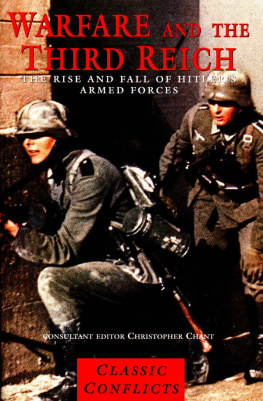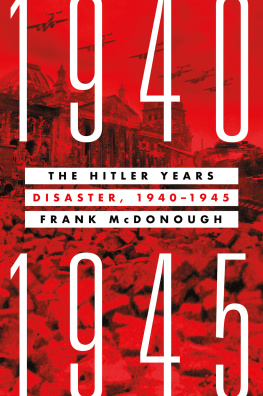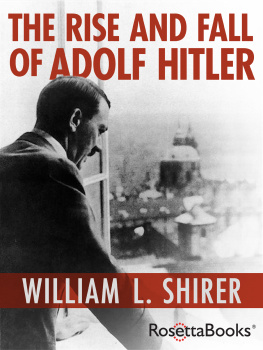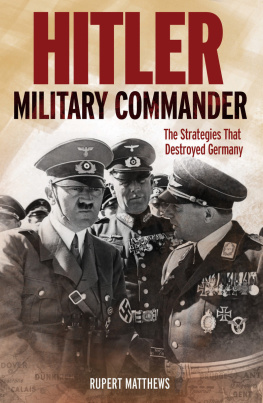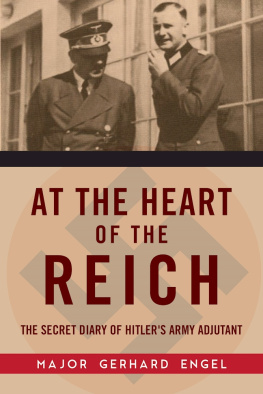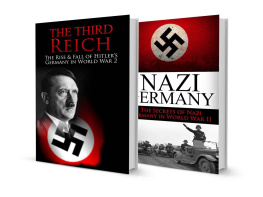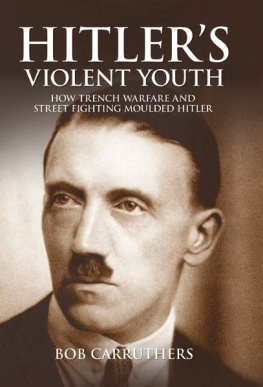CLASSIC CONFLICTS
WARFARE AND THE
THIRD REICH
CLASSIC CONFLICTS
WARFARE AND THE
THIRD REICH
THE RISE AND FALL OF HITLERS ARMED FORCES
CONSULTANT EDITOR CHRISTOPHER CHANT

CONTENTS
THE WESTERN FRONT
THE CAMPAIGNS IN FRANCE AND THE LOW COUNTRIES
THE EASTERN FRONT, JUNE 1941FEBRUARY 1943
THE CAMPAIGN IN RUSSIA, FROM MINSK TO STALINGRAD
THE MEDITERRANEAN FRONTS
THE CAMPAIGNS IN NORTH AFRICA AND ITALY
THE EASTERN FRONT, FEBRUARY 1943MAY 1945
THE CAMPAIGN AGAINST RUSSIA, FROM KURSK TO BERLIN
THE POLITICAL FRONT
HITLER AND HIS HIGH COMMAND
PART 1
HITLERS WAR MACHINE
GERMANY IN THE THIRTIES
T he Treaty of Versailles, signed in the Hall of Mirrors in the palace of the French Sun King on June 28, 1919, the anniversary of the Sarajevo murders, would, it was fervently hoped by Mankind, banish for ever the spectre of German aggression. Under the Treaty Germany lost 25,000 square miles of territory, six-and-a-half million subjects, over half of them German-speaking, and much valuable industrial potential, particularly in Upper Silesia. In the west Alsace-Lorraine, annexed by victorious Prussia in 1871, was restored to France. As partial compensation for the ravages of war, the industrial Saarland was placed under French administration for 15 years. In the north a plebiscite returned Danish-speaking North Schleswig to Denmark. In the east the triumph of nationalism a dynamic historical force, largely outside the control of Woodrow Wilson, Lloyd George and Clemenceau, which had already destroyed three giant empires in a matter of weeks before the Peace Conference met cost Germany much land in Posen, West Prussia and Pomerania.
It was here that the peace settlement was most bitterly resented; the separation of East Prussia from the rest of the Reich by the so-called Polish Corridor and the creation of the anomalous Free State of Danzig under League of Nations control (to guarantee Polish access to port facilities) were in German eyes intolerable impositions to be endured just so long as Germany was weak and despised. Resentment though less acute was aroused by the allied powers refusal to permit the union of Austria and Germany so that when Hitler annexed Austria in 1938 his action could be represented, plausibly enough, as a rectification of a blatant injustice in the application of the self-determination principle. Germany lost all her former colonial possessions, which were taken over by the League of Nations and administered by the victorious powers as mandated territories.
As Prussian militarism was widely regarded as a major cause of the war, Germany was severely restricted in respect of armaments. She was forbidden to have military aircraft, heavy weapons and tanks; the general staff was abolished; conscription was forbidden; and she was allowed a professional army of no more than 100,000 men and 4000 officers. In addition, the Rhineland and a 50-kilometre strip on the right bank was permanently demilitarised and an allied army of occupation stationed there for 15 years. Severe restrictions were imposed on the navy which was limited to 15,000 men, forbidden to have submarines, and allowed a total of 12 cruisers and 24 destroyers. The Kiel Canal was internationalised and coastal defences restricted. Finally, Germany was forced to acknowledge her sole war guilt and was saddled with an unknown burden of reparations. The fact that the German delegation was allowed only 48 hours in which to register objections strengthened the widespread conviction in Germany that the treaty was a Diktat deriving its validity exclusively from the armed might of the victors.
No major power takes kindly to defeat, especially a country as accustomed to the ostentatious display of power as Imperial Germany. The shock of defeat, revolution and economic dislocation failed to bring about any radical re-appraisal of Germanys foreign policy objectives. The permanent officials who staffed the foreign office in the Wilhelmstrasse and the military establishment in the ministry of defence in the nearby Bendlerstrasse lived on happily in the power-conscious world of 1914 believing as steadfastly as ever in Germanys natural right to dominate Europe. Left to their own devices by successive chancellors and presidents, they set about the uphill task of reversing the verdict of the battlefield as quickly as possible.
Geography made Germany the country of the middle destined to live in constant fear of being encircled and trapped into disastrous two-front wars by envious and powerful neighbours to east and west of her. Subjugation or conquest were the stark strategic alternatives facing her in the twentieth century. No middle way was open to her or so it seemed to Germanys political and military rulers between 1871 and 1945. The same reasoning was applied to her future as a highly industrialised power. Unless she wished to remain dangerously dependent on foreign countries for the ever-increasing quantities of food and raw materials essential for survival, then the only alternative compatible with national independence was the creation of a Grossraumwirtschaft in Central and Eastern Europe, an economically self-sufficient area dominated by Germany and responsive to her economic needs. And in a sense the pre-occupation with Weltpolitik at the beginning of the twentieth century was an attempt to correct the precarious balance of diplomatic and economic power in Europe in Germanys favour by transforming her into a broadly-based world power with colonial possessions and a large navy.
Paradoxically enough, the general strategic situation in 1919 was potentially much more favourable for the realisation of these ambitions than ever before in German history. The collapse of Imperial Russia and its replacement by a weak and ostracised Bolshevik regime removed at a stroke the Slav nightmare that so oppressed Germanys leaders in 1914. Where the mighty Romanov and Habsburg empires once stood, was a mosaic of medium-sized and small states, economically weak, divided by deep suspicions and unlikely in the long run to represent a serious obstacle to German ambitions notwithstanding strenuous French efforts in the 1920s to create a cordon sanitaire in the Little Entente and to cultivate the Polish connection. In the west victorious Britain and France were manifestly weakened by the economic price of war and by the withdrawal of America into isolation. French power might be irresistible in the short term as the traumatic experience of the occupation of the Ruhr by French forces in 1923 and the subsequent capitulation of the German government amply demonstrated. But the essential unity of the Bismarckian Reich had survived peace treaty and Ruhr invasion; so that once Germany had a sizeable army at her disposal she stood every chance of being able to re-establish her political and economic hegemony in Europe in the long run in the absence of countervailing Russian and American pressure.
Within the narrow constraints of the treaty the foundations of a first-class army were already being laid in the 1920s largely through the efforts of General Hans von Seeckt, the talented and imaginative chief of army command. What the new Reichswehr lacked in numbers was more than compensated for by a high level of efficiency and intensive training in the tactics of mobile warfare. The Blitzkrieg tactics of 1939-41 with their emphasis on armour and air power were forged twenty years before in the manoeuvres and war games Seeckt made an integral part of officer training. With government connivance, the army successfully evaded many of the disarmament provisions of the treaty. The general staff survived thinly disguised as a
Next page
